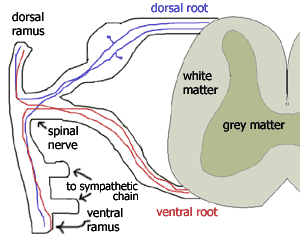Spinal nerve
|
|
The term spinal nerve generally refers to the mixed spinal nerve, which is formed from the dorsal and ventral roots that come out of the spinal cord. The spinal nerve is the bit that passes out of the vertebrae through the intervertebral foramen.
There are a total of 31 bilaterally-paired spinal nerves :
- 8 cervical
- 12 thoracic
- 5 lumbar
- 5 sacral
- 1 coccygeal
The first to seventh cervical nerves (C1 to C7) exit from the vertebral canal above the respective cervical vertebra (that is to say, C1 exits above the first cervical vertebra; C2 exits above the second, and so forth). The C8 spinal nerve exits below the seventh cervical vertebra, and all the other spinal nerves leave below their corresponding vertebra.
Formation of the spinal nerves
Inside the spinal cord, there is grey matter, surrounded by white matter. From out of the grey matter, two dorsal roots (one on the left side, and one on the right side) and two ventral roots emerge. The dorsal roots contain sensory axons, and the ventral roots contain motor axons.
Dorsal means back, ventral means front. As the body is symmetrical, the same thing happens on both the left and right side of the body. This happens in each vertebra of the spine.
The dorsal roots of each side continue outwards, along the way forming a dorsal root ganglion (also called a spinal ganglion).
The ventral roots similarly continue out from the spinal column, and meet and mix with their corresponding dorsal nerve root at a point after the ganglion. At this point they are called a mixed spinal nerve.
Fate of the spinal nerve
Soon after their formation, from the each of the spinal nerves, a dorsal and a ventral ramus emerge. The dorsal ramus will supply muscles and sensory nerves of the back.
To make terminology more confusing, the ventral rami are called roots of the various nervous plexuses (e.g. brachial plexus). From the plexuses (or plexi) arise the sensory and motor nerves of the limbs.
Before forming the plexuses, the ventral rami also have two branches leading to the sympathetic ganglion. (These ganglia connect to the one above and below them, forming the sympathetic chain.)
Importance of the spinal nerves
The muscles that one particular spinal root supplies are that nerve´s myotome, and the dermatomes are the areas of sensory innervation on the skin for each spinal nerve. This is of great importance in the diagnosis of neurological disorders, as lesions of one or more nerve roots result in typical patterns of neurologic defects (muscle weakness, loss of sensation) that allow localisation of the causating lesion.

